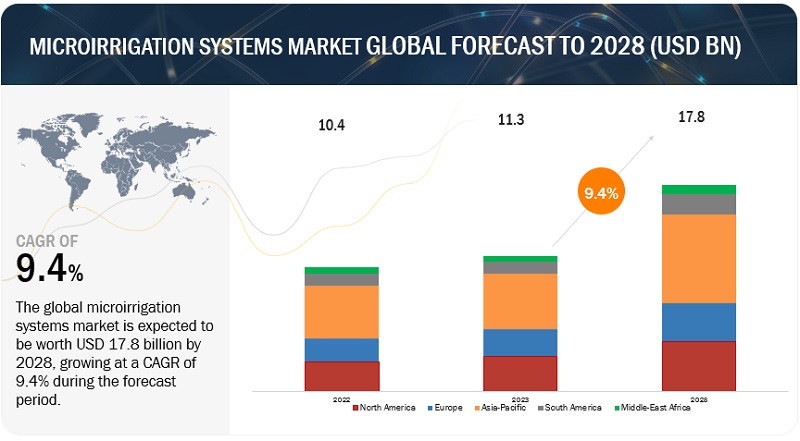The microirrigation systems market size was valued at USD 10.4 billion in 2022 and is expected to reach USD 17.8 billion by 2028, with a compound annual growth rate (CAGR) of 9.4% during the forecast period. Microirrigation devices deliver water directly to the root zone of plants, ensuring optimal moisture levels and reducing water stress. This targeted water application fosters healthier plant growth, leading to increased crop yields and improved produce quality. With the rise of urban agriculture and rooftop farming, where water availability is critical, micro-watering systems are becoming an attractive option. They efficiently utilize limited water resources and provide controlled irrigation in confined spaces. These factors are driving the growth of the microirrigation systems market.

Microirrigation Systems Market Trends
Here are some key trends in the Microirrigation Systems Market:
Increased Adoption of Water-Saving Technologies: With growing concerns over water scarcity, farmers are increasingly adopting microirrigation systems to optimize water usage, reduce waste, and improve crop yields.
Technological Advancements: Innovations such as automated irrigation systems, sensors, and smart controllers are enhancing the efficiency and precision of microirrigation systems. These technologies help farmers monitor soil moisture levels and adjust irrigation schedules in real time.
Government Support and Incentives: Many governments are promoting the use of microirrigation through subsidies, grants, and training programs to encourage sustainable agriculture practices and improve water conservation.
Rising Demand for High-Value Crops: The increasing cultivation of high-value crops, such as fruits and vegetables, is driving the demand for efficient irrigation solutions. Microirrigation systems provide the necessary control over water and nutrient application for these crops.
Sustainable Agriculture Practices: There is a growing emphasis on sustainable farming methods, which promote the use of microirrigation as it minimizes soil erosion, reduces chemical runoff, and improves soil health.
Growth in Developing Regions: As agriculture becomes more mechanized and technologically advanced in developing countries, the demand for microirrigation systems is rising. These regions are witnessing investments in irrigation infrastructure to enhance food security.
Integration with IoT and Precision Agriculture: The integration of microirrigation systems with Internet of Things (IoT) technologies is on the rise. This allows for more precise monitoring and control, leading to better resource management and crop performance.
Focus on Organic Farming: As the demand for organic produce increases, farmers are turning to microirrigation systems to manage water and nutrients effectively while adhering to organic farming practices.
Environmental Awareness: There is a growing awareness of the environmental impact of traditional irrigation methods, prompting farmers to adopt more efficient microirrigation solutions to reduce their ecological footprint.
Download PDF Brochure: https://www.marketsandmarkets.com/pdfdownloadNew.asp?id=566
What specific factors are driving the demand for microirrigation systems in areas experiencing drought?
Advanced irrigation systems have made it possible to protect agricultural fields from drought. Effective irrigation scheduling techniques have led to notable successes among farmers, and the adoption of technology-driven scheduling is on the rise. With microirrigation, farmers can maintain consistent production levels even during drought years, as these systems use minimal water resources while still achieving high yields. The variety of available systems, ranging from simple methods for recording water usage to sophisticated tools that monitor soil moisture, has empowered farmers from diverse backgrounds to address water shortages during dry spells. These irrigation solutions enable farmers to sustain high yields with limited water usage. Additionally, smart irrigation tools highlight that drip irrigation systems are generally more efficient than traditional sprinkler systems. This efficiency is a crucial factor driving the growth of the microirrigation systems market, especially in tropical regions prone to frequent droughts.
The Asia Pacific region is projected to experience the fastest growth throughout the study period.
Climate challenges in the Asia-Pacific region include erratic rainfall, droughts, and heat waves. Microirrigation systems offer precise and efficient water distribution, enhancing resilience to extreme weather conditions. Farmers can adjust irrigation schedules and water applications based on the specific needs of each crop, enabling them to withstand and adapt to changing climate conditions. In some regions, irrigation water may contain high levels of salts, heavy metals, or other contaminants. To address these issues, microirrigation systems can be equipped with filtration and purification devices, ensuring that plants receive clean water. By improving water quality, microirrigation promotes better crop health and higher yields.
Top Microirrigation Systems Companies:
Eminent players operating in the microirrigation systems market are Jain Irrigation Systems Ltd. (India), The Toro Company (US), Netafim (Israel), Nelson Irrigation (US), Rain Bird Corporation (US), Finolex Plasson (India), Mahindra EPC Irrigation Limited (India), T-L Irrigation (US), Hunter Industries (US), Rivulis (Israel), Chinadrip irrigation Equipment Co., Ltd. (China), Elgo Irrigation Ltd. (Israel), Antelco (Australia), Microjet (South Africa), and Irritec S.p.A. (Italy), among others.
Key Questions Addressed by the Microirrigation Systems Market Report:
Which are the major companies in the microirrigation systems market? What are their major strategies to strengthen their market presence?
What are the drivers and opportunities for the microirrigation systems market?
Which region is expected to hold the highest market share?
What are the challenges that could restrict market growth of the microirrigation systems market?
What is the total CAGR expected to be recorded for the microirrigation systems market during 2023-2028?







